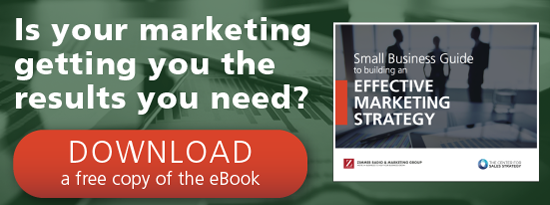Missouri Marketing Resource Blog

5 Tips for Avoiding Sale and Promotion Burnout
 Whether your business is B2B or B2C, sale and promotion burnout are very real risks. It's an easy pitfall to stumble into: Discounts bring in new customers, and to keep them coming in often and spending, you keep the sales rolling only to discover that now, normal prices are actively objectionable, customers will only shop during sales and promotions, your products and services aren't perceived as being quality or valuable, and your marketing is less and less effective. According to one study, clickthrough rates decrease by half after five months of the same ads running. What's more, in some cases you may even end up losing customers to more expensive competitors! In the post below, we'll talk about how to prevent sale and promotion burnout with five tips.
Whether your business is B2B or B2C, sale and promotion burnout are very real risks. It's an easy pitfall to stumble into: Discounts bring in new customers, and to keep them coming in often and spending, you keep the sales rolling only to discover that now, normal prices are actively objectionable, customers will only shop during sales and promotions, your products and services aren't perceived as being quality or valuable, and your marketing is less and less effective. According to one study, clickthrough rates decrease by half after five months of the same ads running. What's more, in some cases you may even end up losing customers to more expensive competitors! In the post below, we'll talk about how to prevent sale and promotion burnout with five tips.
1. The Best Advertising Is Branding and Action Combined
At Zimmer Radio we often discuss two kinds of marketing campaigns with our clients — action and awareness. Sales and promotions are advertised with action campaigns; that is, there's a call-to-action with clear instructions that are designed to make customers want to stop what they're doing and head for your business. The ROI for action campaigns is easier to measure, so it's understandable to think that your emphasis ought to be mostly on this kind of campaign. Unfortunately, this sort of emphasis is also how sale and promotion burnout happens.
Awareness campaigns are harder to measure because they take a long time to come to fruition. However, this kind of campaign is vital because it isn't selling customers on an event or other promotion — it's selling customers on your brand as authentic and authoritative. It's intended to help customers get to know and trust your brand without the added impetus of getting to pay bottom dollar. Obviously only utilizing awareness campaigns would have diminished benefits because of their long term goals, whereas your business most certainly has short term needs.
Doing It Right
Make use of both styles of advertising campaigns. Using each at the right time in the right way will better position your brand as worth your normal prices, while promotions and sales with specific calls-to-action will give customers a reason to take action.
2. Find the Ideal Frequency for Your Advertising
The ideal situation, as we said, is finding the balance of prompting high engagement and conversion while strengthening brand awareness without burning out your customers. That means finding the sweet spot between too much and too little of both. This spans across all types of advertising media, whether you're looking at social media and email marketing or radio plays.
Why is frequency so difficult? You have to find the right metrics to utilize, and have the right tools to utilize them accurately. Cookies, for example, are a major tool for tracking reach and conversions online; unfortunately, it can also wildly skew your numbers (up by 58% for reach, down 141% for frequency.) Similarly, it may be easy to determine that an ad is doing well (or poorly) but not offer enough analytical information to help you determine why that's so.
The answer is also not one-size-fits-all. What works for radio may not work for social media, or even internet radio, for that matter.
Doing It Right
This is where the importance of understanding audience segmentation and targeting comes into play. Strategically targeting customers, encoding a method for individual frequency caps, rotate creatives, retargeting with new creatives, and test, test, test.
3. Create Urgency or Scarcity for Sales and Promotions
This may sound obvious, but don't let your sales run on for forever, and don't let one sale constantly roll on into another. For one thing, it makes "sale" lose its meaning at your business, because regular prices are never in play. For another, it means you're constantly promoting the sale, or promoting sale after sale, increasing the likelihood of burning customers out. Plus, according to one study, less than a third of ecommerce site hits are returning visits. That means that customers that don't make a decision to purchase that day probably don't come back to buy later.
Doing It Right
Always have an expiration date. Whether it's a real deadline — like a holiday — or an invented one — order by this time to get this item by this day — a deadline actively mentioned in marketing copy creates urgency, ensuring a customer is less likely to put a purchase off or forget about it. Promotional marketing should also have an expiration date that aligns with the offer.
Scarcity is also a major decision driver that sidesteps burnout. Limited quantities of items are known to increase the odds of purchase and increase behavior such as in-store hoarding — holding on to items a customer isn't actually sure they want, but are sure they don't want another customer to grab in the meantime, which further increases the perception of scarcity — In some cases, the scarcity isn't entirely true in that the limitations are self-set and have nothing to do with a "shortage" Take the McRib, for example. However, do not create truly artificial scarcity — it will backfire, losing customer loyalty in droves.
4. Ensure Information Is Readily Available
Do a Google search for "Why should you make information easy to find?" and you'll get nearly three billion responses. Among the top ten are the CDC and the National Institutes of Health. Why? Because having information that's easy to understand is key for everyone to be able to execute. The same should always be true of your promotions. Nothing burns a customer out faster than being interested in a deal, new product or service, but being too confused to understand how to follow through. It's due, in part, to the growing trend of mobile searches, browsing, social media, and shopping.
You may be wondering, what does that have to do with my promotions? Quite frankly, these trends have caused a vital shift in consumer behavior. Your customers are going to search for information on impulse — possibly via mobile even after hearing a radio ad — and then expect to find and read that information quickly. When they can't, they're going to leave those sources of information and move on to something else, possibly to doing something else entirely. What are your customers going to find when they move from your marketing to searching for information?
Doing It Right
This is why you should have information for promotions available across all channels. Even if a certain promotion is only available for people that hear a radio ad or who shop at your store online, the promotion information should be available in both places. The same is true of social media.
5. Ensure Promotions Are Taken Seriously by Having Truly Incredible Offers
Having sales running all the time doesn't just mean that the word "sales" will lose its meaning — it also means that you're training customers to only come in when the price is right. In an effort to make a promotion meaningful, you may try to constantly outdo yourself, offering "better" deals every time. Eventually, that's going to hurt your bottom line, and hurt it badly. Eventually, this makes trying to sell any particular promotion as a good time to come in (e.g., "best sale of the year") almost laughable; you lose authority, and you lose credibility.
What does an "incredible offer" mean, then? Certainly, it can't be something you've done all along and are only now advertising. They need to be timely, and they need to be special. Perhaps that means targeted offers for people listening on the radio or who have signed up for your newsletter.
It also means engendering a sense of priority. This is in addition to urgency and scarcity. Think about Macy's, or Bed Bath and Beyond. Customers largely ignore them because these "tabloid-type mailers" are stuffed in mailboxes all the time; if you miss this one, you can use the next one because it won't be long before you receive it.
Doing It Right
Remember that promotions need to be tailored to your business. In some cases, offering a catalog that doesn't look like a catalog (as with Patagonia, Anthropologie) is intriguing enough to grant priority, not to mention highlight sales and promotions of interest. Sometimes, it's just about offering sales in the right way. Companies like Valve, Corel Software, and JetBlue found that rarity, hyper-targeting, and retargeting brought success to promotions.
Remember, sales and promotions can do a lot of good for your business. It's a matter of doing them in the right way at the right time. As the saying goes, "man cannot live by bread alone," likewise a business cannot thrive on discounts and promotions alone. You need to engender loyalty in your brand — in your store or your products or services — and not merely loyalty to the bottom dollar. Follow our tips, and you can be sure that sale and promotion burnout won't relegate you to the position of low-cost provider in your customers' minds.

